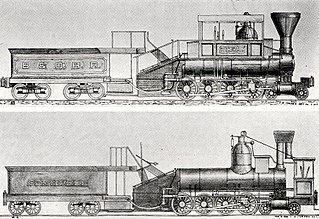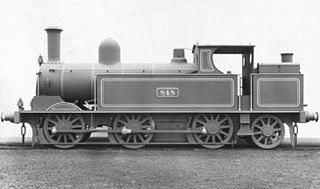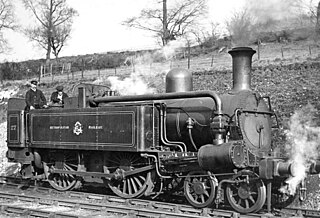
4-4-0 is a locomotive type with a classification that uses the Whyte notation for the classification of steam locomotives by wheel arrangement and represents the arrangement: four leading wheels on two axles, four powered and coupled driving wheels on two axles, and a lack of trailing wheels. Due to the large number of the type that were produced and used in the United States, the 4-4-0 is most commonly known as the American type, but the type subsequently also became popular in the United Kingdom, where large numbers were produced.

A 4-6-0 steam locomotive, under the Whyte notation for the classification of steam locomotives by wheel arrangement, has four leading wheels on two axles in a leading bogie and six powered and coupled driving wheels on three axles with the absence of trailing wheels.
Sir Vincent Litchfield Raven, KBE was an English railway engineer, and was chief mechanical engineer of the North Eastern Railway from 1910 to 1922.

Under the Whyte notation for the classification of steam locomotives, 4-8-0 represents the wheel arrangement of four leading wheels on two axles, usually in a leading truck or bogie, eight powered and coupled driving wheels on four axles and no trailing wheels. In North America and in some other countries the type was usually known as the Twelve-wheeler.
Under the Whyte notation for the classification of steam locomotives, 0-8-0 represents the wheel arrangement of no leading wheels, eight powered and coupled driving wheels on four axles and no trailing wheels. Locomotives of this type are also referred to as eight coupled.
Under the Whyte notation for the classification of steam locomotives, 0-8-2 represents the wheel arrangement of no leading wheels, eight powered and coupled driving wheels on four axles, and two trailing wheels on one axle.

The London and North Western Railway (LNWR) Webb Coal Tank is a class of 0-6-2T steam locomotive. They were called "Coal Tanks" because they were a side tank version of Webb's standard LNWR 17in Coal Engine, an 0-6-0 tender engine for slow freight trains.

The Metropolitan Railway A Class and B Class were 4-4-0T condensing steam locomotives built for the Metropolitan Railway by Beyer Peacock, first used in 1864. A total of 40 A Class and 26 of the slightly different B Class were delivered by 1885. Used underground, the locomotives condensed their steam, and coke or smokeless coal was burnt to reduce the smoke.

The Furness Railway 21 class or "Larger Seagulls", were built a class of eight 4-4-0 steam locomotives designed by W. F. Pettigrew and built by Sharp, Stewart and Company of Glasgow for the Furness Railway. Six were built in 1896, and two more in 1900. They were built to supersede the 120 class on the heavier and more important trains and were in turn replaced on the railway’s top trains with the 115 class in the 1920s. They had 6-foot-0-inch (1.829 m) diameter driving wheels with 18-by-24-inch cylinders.

The North Eastern Railway Class D was a class of 4-4-4T three-cylinder side tank steam locomotive designed by Vincent Raven in 1913. They were used for rural passenger services. Forty five were built in total; a first batch of twenty, then a further twenty five after the War.

The North Eastern Railway (NER) Class H, classified as Class Y7 by the London and North Eastern Railway (LNER) is a class of 0-4-0T steam locomotives designed for shunting.

James Holden was an English locomotive engineer.

The NER Class X was a class of 4-8-0T tank locomotive designed by Wilson Worsdell for the North Eastern Railway. They were intended for use as powerful shunting engines to arrange and move coal wagons for loading into ships. In total 15 were built, 10 by the NER between 1909 and 1910, and a further five in 1925 by the London and North Eastern Railway (LNER). They had three cylinders with divided drive: the inside cylinder driving the leading axle, the outside cylinders driving the centre.

The GWR Class 850 was an extensive class of small 0-6-0ST locomotives designed by George Armstrong and built at the Wolverhampton railway works of the Great Western Railway between 1874 and 1895. Aptly described as the GWR equivalent of the LB&SCR "Terrier" Class of William Stroudley, their wide availability and lively performance gave them long lives, and eventually they were replaced from 1949 by what were in essence very similar locomotives, the short-lived 1600 Class of Frederick Hawksworth, which in the headlong abandonment of steam outlived them by a mere seven years or so.
Under the Whyte notation for the classification of steam locomotives, 2-2-2-0 usually represents the wheel arrangement of two leading wheels on one axle, four powered but uncoupled driving wheels on two axles, and no trailing wheels, but can also be used to represent two sets of leading wheels two driving wheels, and no trailing wheels. Some authorities place brackets around the duplicated but uncoupled wheels, creating a notation 2-(2-2)-0, or (2-2)-2-0, as a means of differentiating between them. Others simply refer to the locomotives 2-2-2-0.
A divided drive locomotive is a steam locomotive that divides the driving force on its wheels by using different cylinders to power different pairs of driving wheels in order to give better weight distribution and reduce "hammer blow" which can be damaging to the track, or else to enable the wider spacing of the driving wheels to accommodate a larger firebox.

The NER Class 290 was a class of 0-6-0T steam locomotives of the North Eastern Railway (NER), rebuilt from an earlier class of 0-4-4T, the NER Bogie Tank Passenger.
GCR Class 9P was a design of four-cylinder steam locomotive of the 4-6-0 wheel arrangement built for hauling express passenger trains on the Great Central Railway in England. A total of six were built: one in 1917, and five in 1920. They were sometimes known as the Lord Faringdon class, from the name of the first one built.

The LNWR 18-inch Goods was a class of 310 0-6-0 freight steam locomotives built by the London and North Western Railway at their Crewe Works between 1880 and 1902.
The NER Class Z was an Atlantic class of locomotives designed by Vincent Raven. It was introduced in 1911.














